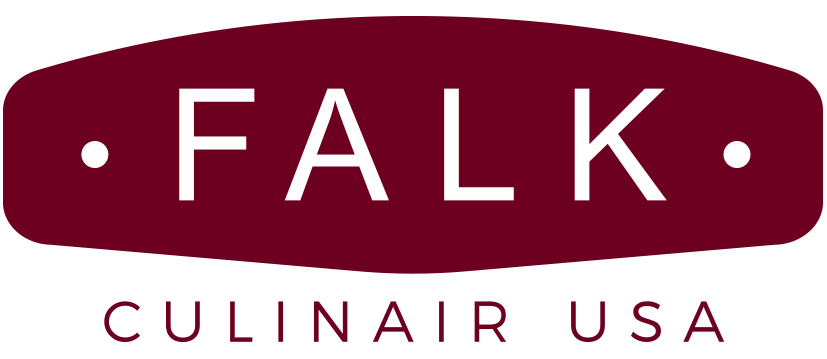FAQ
What is the difference between the Classic, Signature and Copper Coeur Collection pans?
All Falk Culinair collections are handcrafted in our Belgium workshop.
The Classic and Signature Collection vessels are made from the same 2.5 mm copper / 0.2 mm stainless steel bimetal. The difference is the handle. All handles are securely attached to the vessel using rivets.
The Classic Line utilizes the original cast iron handle. It has a traditional hand-crafted look and ergonomic shape. The Classic Line has the most pan size options available.
The Signature Line has a contemporary, sleek stainless steel handle. This handle stays cooler than cast iron and has a more modern look.
The Copper Coeur Line is a three layer pan. It still has the same 0.2mm stainless steel lining of the other pans fused with a 1.9mm copper core. The difference is the exterior, Copper Coeur has a 0.4mm ferritic stainless steel exterior that makes it compatible with induction ranges. The handles are the same stainelss steel as our Signature Line. The vessels are exactly the same size as the other lines. At this time larger pans are not available in the Copper Coeur Line.
What is “Falk Bimetal”?"
Falk cookware is made from a 2.3 mm copper plate on which a 200 micron (0.2mm) layer of stainless steel is applied under 850 tons/cm² of pressure. The resulting metallic intercrystalline connection creates a pan material with the heat conduction benefits of copper and the benefits of stainless steel for food contact.
Do I need to season my pan?
The instructions that come with your pan do describe seasoning the inside of the pan. It is not necessary. The stainless steel lining can be used as is and cleaned normally. However, if you wish for a more non-stick surface it can be seasoned. If you would like to do it:
Heat your pan. When hot, wipe the pan with a small amount of high smoke point oil (sunflower, grapeseed). Continue heating just to the point of smoking, about 350 degrees F, and hold for about one minute. Do not continue heating to the point of burning the oil. Remove from heat and let the pan cool, then wipe again. Do not wash. Your pan is ready for use.
Seasoning on a stainless steel pan will not last like it does on cast iron or steel.
Why are your pan sizes in metric units?
Our pans are based on the metric system because they are hand-crafted in Belgium. In Europe pans of all types are sized primarily by their diameter. The metric size listed for our pans is based on the diameter at the inside of the top of the pan's lip. We also show approximate US sizes/volumes for reference. Please see the pan's specifications for actual detailed dimensions.
Why are these pans so heavy?
Copper conducts heat very well, but you also need enough copper to properly conduct the heat. We find the traditional 2.5 mm pan thickness to be optimal. That can make the pans heavy. There are thinner and multi-ply pans on the market with thin layers of copper. However, these do not provide the same performance as the thicker pans.
Are Falk Culinair products sold in retail stores?
We are the exclusive distributor of Falk Culinair copper cookware in the United States. At this time, Falk Culinair products are only sold online.
Do you ship outside of the United States?
No. We are a US distributor of Falk products and do not ship outside of the United States. Our About Us page has information on where to buy the product outside of the US.
Can your products be used on glass top ranges?
Our cookware does work on glass/ceramic top ranges!
Can your products be used on induction ranges?
Our Classic and Signature cookware does not contain the necessary iron content to work with induction cooking. Our Copper Coeur Line is fully induction ready.
Can the Copper Coeur Line be used with gas and electric ranges?
The Copper Coeur Line will work very well on gas and electric ranges. It is made to be induction compatible, but it is also a great option for those who want the performance of copper but the ease of use and aesthetic of a stainless steel exterior. The stainless steel exterior is a special ferritic stainless steel and is 0.4 mm thick. Therefore, the copper is a little thinner on this line. It is 1.9 mm instead of 2.3 mm thick. This does mean it will be slightly less responsive on a gas stove than the classic and signature lines. That said, these pans have way more copper than most tri-ply pans and will outperform all of them on induction, electric or gas.
There are pits and marks in my pan, have I ruined it?
Pitting can sometimes happen in our stainless steel lining. If it does, the cookware is still safe to use. There are several factors that can lead to pitting: pan cleaning detergents, cooking method, food ingredients, water hardness, etc. The most common cause is solid salt in water sitting on the bottom of the pan. If you add salt to your water before it's boiling, some of the salt will settle to the bottom of the pan and this may causing pitting to occur..














